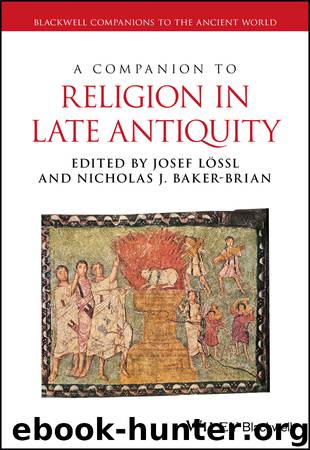A Companion to Religion in Late Antiquity by Unknown

Author:Unknown
Language: eng
Format: epub
ISBN: 9781118968123
Publisher: John Wiley & Sons, Inc.
Published: 2018-05-08T00:00:00+00:00
There were of course other ideas that the heresiologists lumped together with false gnosis, such as numerical and alphabetical mysticism (Marcus), docetic christologies (Basilides), and hostility to procreation (Encratites), but the demiurgical tale appears to be the one they found most problematic.
A House Divided…
If these types of narrative constituted the basis of what some considered false gnosis, what was is it that the proto‐orthodox authorities found so offensive and difficult to accept? As it turns out, this rather otherworldly story struck at the core of several very real‐world issues that the early Church was wrestling with in order to define its evolving relationship with both its Jewish heritage and wider Roman society.
Ever since the conquests of Alexander the Great, ancient Near Easterners were contemplating how to react to the cultural ideology being imposed on them by the occupiers. For various reasons we have more documentation of Jewish responses to this problem than for other communities, whereby we can see that there was a great diversity of opinion both within the Land of Israel and the diaspora. On one side of the spectrum was the Maccabean revolt of the second century BCE, which sought to throw off the yoke of Macedonian domination, only to be submerged later by an even more fearsome imperial machine. On the other side was the highly integrationist approach of the Alexandrian Jewish community, which is not only credited (at least in Jewish folklore) with facilitating the creation of the Septuagint—the Greek translation of the scriptures—but sought to interpret it using the tools of Greek philosophical tradition. Philo epitomized this philhellenic trend and his work would go a long way to normalize the allegorical interpretations of scripture so prevalent in early Christian exegesis.
The earliest Christians faced the same set of choices about whether or not to integrate into their host society. In the wake of another set of Jewish revolts against foreign domination, this time against Rome, two main groups would emerge—the rabbis who offered a reimagined Judaism for Jews and the Christians who essentially offered a Judaism tailor‐made for Gentiles. In fact, it might be argued that the gnosis controversy partly represents a struggle in the early Church over just how far that accommodation could go. This meant establishing limits on Hellenistic allegorization. As Irenaeus claimed, the Valentinians were able to extrapolate the existence of the thirty aeons through exegesis of the Parable of the Laborers in the Vineyard (Mt 20). For him, the Valentinians were “like those who bring forward any kind of hypothesis they fancy, and then endeavor to support them out of the poems of Homer” (Against Heresies 1.9). By doing so they “falsify the oracles of God, and prove themselves evil interpreters of the good word of revelation” (Against Heresies 1 preface). There can be no doubt that the concept of the Fullness (pleroma) of pre‐existing aeons strongly resembles the Platonic world of the forms. In both versions, the world that we perceive with our senses is not the true reality. True
Download
This site does not store any files on its server. We only index and link to content provided by other sites. Please contact the content providers to delete copyright contents if any and email us, we'll remove relevant links or contents immediately.
Joan of Arc by Mary Gordon(3784)
Victory over the Darkness by Neil T. Anderson(2731)
The Gnostic Gospels by Pagels Elaine(2397)
Devil, The by Almond Philip C(2204)
The Nativity by Geza Vermes(2114)
The Psychedelic Gospels: The Secret History of Hallucinogens in Christianity by Jerry B. Brown(2072)
Going Clear: Scientology, Hollywood, and the Prison of Belief by Lawrence Wright(1883)
Going Clear by Lawrence Wright(1871)
A TIME TO KEEP SILENCE by Patrick Leigh Fermor(1774)
Barking to the Choir by Gregory Boyle(1727)
Old Testament History by John H. Sailhamer(1712)
Augustine: Conversions to Confessions by Robin Lane Fox(1686)
A History of the Franks by Gregory of Tours(1636)
The Bible Doesn't Say That by Dr. Joel M. Hoffman(1608)
A Prophet with Honor by William C. Martin(1602)
The Knights Templar by Sean Martin(1597)
by Christianity & Islam(1561)
The Amish by Steven M. Nolt(1489)
The Source by James A. Michener(1455)
